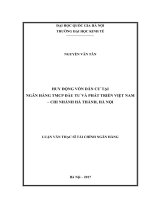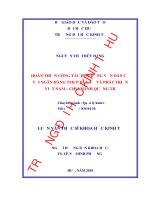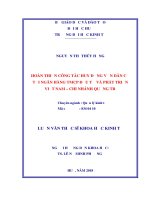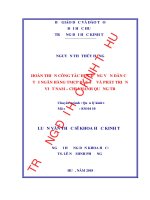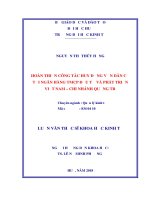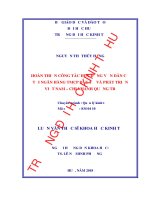Tăng cường huy động vốn dân cư tại ngân hàng tmcp đầu tư và phát triển việt nam chi nhánh đông hà nội
Bạn đang xem bản rút gọn của tài liệu. Xem và tải ngay bản đầy đủ của tài liệu tại đây (1.64 MB, 112 trang )
ĐẠI HỌC QUỐC GIA HÀ NỘI
KHOA QUẢN TRỊ VÀ KINH DOANH
---------------------
ĐỖ QUỲNH TRANG
INCREASING CAPITAL MOBILIZATION AT JOINT STOCK
COMMERCIAL BANK FOR INVESTMENT AND DEVELOPMENT
OF VIETNAM - EAST HANOI BRACH
TĂNG CƯỜNG HUY ĐỘNG VỐN DÂN CƯ TẠI NGÂN HÀNG TMCP
ĐẦU TƯ VÀ PHÁT TRIỂN VIỆT NAM - CHI NHÁNH ĐÔNG HÀ NỘI
LUẬN VĂN THẠC SĨ QUẢN TRỊ KINH DOANH
HÀ NỘI - 2020
ĐẠI HỌC QUỐC GIA HÀ NỘI
KHOA QUẢN TRỊ VÀ KINH DOANH
---------------------
ĐỖ QUỲNH TRANG
INCREASING CAPITAL MOBILIZATION AT JOINT STOCK
COMMERCIAL BANK FOR INVESTMENT AND DEVELOPMENT
OF VIETNAM - EAST HANOI BRACH
TĂNG CƯỜNG HUY ĐỘNG VỐN DÂN CƯ TẠI NGÂN HÀNG TMCP
ĐẦU TƯ VÀ PHÁT TRIỂN VIỆT NAM - CHI NHÁNH ĐÔNG HÀ NỘI
Chuyên ngành: Quản trị kinh doanh
Mã số: 60 34 01 02
LUẬN VĂN THẠC SĨ QUẢN TRỊ KINH DOANH
NGƯỜI HƯỚNG DẪN KHOA HỌC: PGS.TS. PHẠM THANH HÒA
HÀ NỘI - 2020
DECLARATION
The author confirms that the research outcome in the thesis is the result of
author’s independent work during study and research period and it is not yet
published in other’s research and article.
The other’s research result and documentation (extraction, table, figure,
formula,
and other document) used in the thesis are cited properly and the
permission (if required) is given.
The author is responsible in front of the Thesis Assessment Committee,
Hanoi School of Business and Management, and the laws for above-mentioned
declaration.
Date…………………………..
i
TABLE OF CONTENTS
DECLARATION .........................................................................................................i
TABLE OF CONTENTS ............................................................................................ii
LIST OF TABLE ........................................................................................................ v
LIST OF FIGURES.................................................................................................... vi
INTRODUCTION....................................................................................................... 2
CHAPTER 1: OVERVIEW OF MOBILIZING
RESIDENTS’ CAPITAL
ACTIVITIES OF COMMERCIAL BANKS .............................................................. 6
1.1. Overview of commercial banks ........................................................................ 6
1.1.1. Commercial Bank ...................................................................................... 6
1.1.2. Operations of commercial banks ............................................................... 9
1.2. Mobilized capital of commercial banks ......................................................... 13
1.2.1. Concept of mobilized capital ................................................................... 13
1.2.2. The role of mobilized capital ................................................................... 13
1.2.3. Forms of capital mobilization .................................................................. 14
1.2.4. Capital mobilization policy...................................................................... 16
1.3. Mobilizing capital from residents................................................................... 18
1.3.1. Characteristics.......................................................................................... 18
1.3.2. Role .......................................................................................................... 19
1.3.3. Mobilization forms .................................................................................. 19
1.3.4 Assessing activities of mobilizing residential capital of commercial banks22
1.3.5 Factors affecting the mobilization of residential capital of commercial
banks .................................................................................................................. 25
CHAPTER 2: ACTUAL SITUATION OF MOBILIZING RESIDENTAL
CAPITAL ACTIVITIESAT VIETNAM JOINT STOCK COMMERCIAL BANK
FOR INVESTMENT AND DEVELOPMENT – EASTERN HANOI BRANCH .. 30
2.1. Overview of Vietnam Joint Stock Commercial Bank for Investment and
Development - Eastern Hanoi Branch ................................................................... 30
ii
2.1.1. Overview of Vietnam Joint Stock Commercial Bank for Investment and
Development - Eastern HanoiBranch ................................................................ 30
2.1.2. Business operation situation .................................................................... 34
2.2. Actual situation of mobilizing residents’ capital activities at BIDV – the
Eastern Hanoi branch ............................................................................................ 41
2.2.1. Scale of mobilized capital ........................................................................ 41
2.2.2. Structure of residential capital mobilization ............................................ 45
2.2.3. Capital mobilizing activities in terms of criteria ..................................... 59
2.2.4. Analysis of factors affecting the results of residents’ capital mobilization .... 66
2.3. Assessing activities of mobilizing residential capital at BIDV – the Eastern
Hanoi branch ......................................................................................................... 72
2.3.1. Achievements .......................................................................................... 72
2.3.2. Limitations ............................................................................................... 74
2.3.3. Reasons .................................................................................................... 76
Chapter
3:
SOLUTIONS
RESIDENTS’CAPITALMOBILIZATION
TO
ACTIVITIESAT
DEVELOP
BIDV-THE
EASTERN HANOI BRANCH ................................................................................. 80
3.1. Future orientation of mobilizing residential capital activities at BIDV – the
Eastern Hanoi branch ............................................................................................ 80
3.1.1. General orientation for the development of BIDV – the Eastern
Hanoi branch ..................................................................................................... 80
3.1.2. BIDV's capital mobilization strategy ....................................................... 81
3.1.3. Orientation for mobilizing residential capital at BIDV - Eastern
Hanoi branch .................................................................................................... 83
3.2. Solution to strengthen residential capital mobilizationBIDV – the Eastern
Hanoi branch ......................................................................................................... 84
3.2.1. Diversify mobilization forms and mobilized products ............................ 85
3.2.2. Solutions for flexible and competitive banking services ......................... 87
3.2.3. Innovative organizational and management solutions............................. 91
3.2.4. Human resource solutions........................................................................ 92
iii
3.2.5. Solutions to adapt to residential practices ............................................... 93
3.2.6. Improve the quality of using mobilized capital ....................................... 94
3.3. Bank’s recommendations ............................................................................... 95
CONCLUSION ......................................................................................................... 97
REFERENCES .......................................................................................................... 99
APPENDIX ............................................................................................................. 101
iv
LIST OF TABLE
Table 2.1. Business operation of BIDV - the Eastern Hanoi branch in 2015 – 2018 ......35
Table 2.2. Capital mobilized results in BIDV – The Eastern Hanoi branch In the
period of 2015 – 2018 ...............................................................................................38
Table 2.3. Other business of BIDV – the Eastern Hanoi branch ..............................40
Table 2.4. Capital mobilized in scaleofBIDV – the Eastern Hanoi branch in
2015-2018 .................................................................................................................42
Table 2.5. Residents’ capital mobilized in scaleofBIDV – the Eastern Hanoi branch
in 2015-2018 .............................................................................................................42
Table 2.6. Capital mobilized in currency in 2015 – 2018 .........................................45
Table 2.7. Residents’ capital mobilized in terms of maturity in 2015-2018.............47
Table2.10. Average interest rate of some state-own banks in Vietnam in 2018 ......55
Table 2.11. Residents’ capital in terms of promotion saving forms in 2016-2018...56
Table 2.12. Residents’ capital in terms of valuable paper issuing form in 2015-2018 ....58
Table 2.13. Residents’ capital mobilization ratio of BIDV – The Eastern Hanoi
Branch in 2016 – 2018 period ...................................................................................60
Table 2.14. Interest rate and cost for residents’ capital mobilization .......................61
Table 2.15. Residentials capital in mobilizing and credit .........................................62
Table 2.16: Revenue – Expenditure differences of BIDV – The Eastern Hanoi
Branchin 2015-2018 period.......................................................................................63
Table 2.4. Capital mobilized in scale ofBIDV – the Eastern Hanoi branch in 20152018 ...........................................................................................................................63
Table 2.17: Customer evaluation for customer management staff ...........................66
Table 2.18: Deposit mobilization productsof banks in Dong Anh area ....................67
Table 2.19: Customer assessmentsabout mobilized productsof BIDV – the Eastern
Hanoi branch .............................................................................................................68
Table 2.20: Customer assessments about interest rate policy and transaction
procedure at BIDV – the Eastern Hanoi branch .......................................................69
Table 2.21: Customers’ assessment about Marketing policy of BIDV – the Eastern
Hanoi branch .............................................................................................................70
v
LIST OF FIGURES
Figure 2.1: Organization chart of Eastern Hanoi branch ..........................................32
Graph 2.1. Annual resident’s capital mobilized in 2015– 2018 ...............................43
Graph 2.2. Capital mobilized in currency in 2015 – 2018 ........................................46
Graph 2.3. Annual residents’ capital mobilizes in 2015– 2018 ...............................48
Graph 2.4. Annual residents’ capital mobilizes in terms of form in 2015– 2018 .....50
Table 2.8. Residents’ capital in terms of mobilized forms in 2015-2018 .................52
Table 2.9. Capital mobilized in terms of currency 2016-2018 .................................54
Graph 2.5. Annual residents’ capital mobilizes in terms of currency Incommon
form (2016– 2018) ....................................................................................................54
vi
1
Thesis: “STRENGTHENING THERESIDENT’S CAPITAL MOBILIZATION
AT JOINT STOCK COMMERCIAL BANK FOR INVESTMENT AND
DEVELOPMENT OF VIETNAM (BIDV) -EASTERN HANOI
BRANCH”INTRODUCTION
1. Thesis’s necessaryRationale
Mobilizing capital is one of the main activities of commercial banks. In recent
years, along with the establishment of many domestic commercial banks as well as
the appearance of foreign banks, capital mobilization has faced to a fierce
competition. Each commercial bank, based on its capabilities and conditions, has set
up its measures and solutions to implement capital mobilization. Joint Stock
Commercial Bank for Investment and Development of Vietnam (BIDV) is one of
the leading banks in commercial banking system of Vietnam. Through 60 years of
establishment and development, BIDV has affirmed its reputation in the market.
Bank for Investment and Development of Vietnam – the Eastern Hanoi Branch is
one of branch in Hanoi accounting for a relatively large market share, especially in
Dong Anh, Soc Son and suburban areas. However, due to operation of many credit
and financial institutions in the area, the competition has been getting fiercer.
Therefore, the mobilization of resident’s capital of the Branch has been faced with
many difficulties which is negatively affecting to the Growth rate and market share
of the Eastern Hanoi Branch.Therefore, it is necessary to have a scientific,
comprehensive, specific and profound research to find effective solutions to ensure
that the Branch can attract capital from the residents, maintain and develop its
market share in the locality, ensure business efficiency and implement its business
plan. This is a very urgent issue which is, in one hand, meeting the practical reality
requirements of commercial banks,and in other hands, meeting the current issue in
business operation of commercial bank. Because of the above reasons, the issue of
"Strengthening the mobilization of residential capital at Joint Stock Commercial
Bank for Investment and Development of Vietnam- Eastern Hanoi Branch" has
been chosen as a topic of master's thesis specialized in Business Management.
2. Research objectives and tasks
2
The objectives of this thesis is suggest some solutions to strenghen
mobilization of residential capital in the coming time. .
To reach the goals of research, the thesis solve some specific tasks as follows:
Firstly, systematizing the theoretical issues of residential capital
mobilizationof commercial banks.
Secondly, analyzing the status of business operations; activities of
mobilizing residential capital of BIDV – Eastern Hanoi Branch, clarifying
achievements, shortcomings and reasons.
Thirdly, proposing feasible solutions to strenthenresidential capital
mobilization in the coming time at BIDV – Eastern Hanoi Branch.
3. Subjects and scope of research
3.1.
Subjectof the research
The mobilizing residential’s capital activities of BIDV – Eastern Hanoi
Branch.
3.2.
Scope of the research
-
In terms of time: 2015-2017 period, some targets were updated to 2018.
-
In terms of space: BIDV – Eastern Hanoi Branch.
4. Research Methodology
* Data analysis method
- Comparison method by absolute numbers
This method is used to compare year-on-year data with previous year's
figures for volatility and find out the causes of fluctuations in those indicators to
make corrective measures.
- Comparison method by relative number:
This method is used to clarify the level of volatility of economic indicators.
Comparing the growth rates of year-on-year indicators to find out the causes and
remedies.
* Visual method
- Tables: show the annual data on the tables
3
Formatted: Indent: First line: 0.39", Space
Before: 0 pt, After: 0 pt, Line spacing: 1.5
lines
Formatted: Indent: First line: 0.39", Space
Before: 0 pt, After: 0 pt, Line spacing: 1.5
lines
- Charts: vividly describe the situation of increasing and decreasing over the
years.
* SWOT matrix analysis
- List strengths, weaknesses, opportunities and threats
- Combine strengths and opportunities to come up with strategies
- Define weaknesses and threats to propose solutions
- Set up opportunity assumptions to overcome or limit weaknesses
Data source is exploited from annual business performance reports of BIDV
– Eastern Hanoi Branch in 2015, 2016, 2017.
5. Literature review
Residential capital mobilization is nota new topicthat has been reviewed by
many authors. Previous studies had been studied on many different aspects, some of
them includes:
- "Solutions to increase capital mobilization from residents of Bank for
Investment and Development of Vietnam (BIDV) – Transaction Office 3" by Dang
Cong Ngoc, 2010.
- "Solutions to strengthen the mobilization of residents’ capital of JSC Bank
for Foreign Trade of Vietnam - Transaction Offices" by Nguyen Thanh Mai, 2009.
- “Some solutions to increase capital mobilization in current time of Vietnam
Bank for Agriculture and Rural Development (Agribank) - Hanoi branch" by
Nguyen Thanh Tung, 2009.
- Master thesis: "Solution to mobilize residential capital at Vietnam Joint
Stock Commercial Bank for Investment and Development - Da Nang branch" by Do
Van Nhat, 2013.
The above topics just analyzed capital mobilization activities and assessing
capital mobilization activities in separate aspects such as structure, scale of capital
mobilization or capital mobilization cost. On that basis, some solutions to increase
capital mobilizationwere proposed. However, those solutions had just met
requirements of capital mobilization revenue, but not satisfied the requirements
involved inanalysis and evaluation of effectiveness of capital mobilization
4
Comment [Office1]: Phầnnày em phải sơ lượ
qua đượcnhững cơng trìnhnàycủahọđãlàmđượcg
chưa làmđượcgìđểtừđó em mới đưa đếnkếtluậnl
cơng trìnhcủa em khơng bịtrùnglặpvới cơng
trìnhcủahọ
activities. Furthermore, there was no comprehensive and effective solutions to
improve capital mobilization. It is a fact that, previous solutions cannot be accepted
by the bank to meet the target of “the cheapest cost of capital - the highest profit”.
Besides, with specific features and different development strategies in
specific period and stage, banks will have different directions and solutions to
improve its operation. It is currently similar to the situation of the Vietnam Bank for
Investment and Development Bank –Eastern Hanoi Branch.Furthermore, there is a
shortage of official research on the mobilization of residential capital of the branch.
Therefore, I would like to choose the topic: “Strengthening the mobilization of
residential capital at Joint Stock Commercial Bank for Investment and Development
of Vietnam- Eastern Hanoi Branch” as a theme for my master thesis.
6. Thesis structure
In addition to the introduction and conclusion, this thesis includes three
chapters:
Chapter 1: Overview of mobilizing residents’ capital of commercial banks
Chapter 2: Actual situation of residential capital mobilization activities at
Vietnam Joint Stock Commercial Bank for Investment and Development –Eastern
Hanoi Branch.
Chapter 3: Solutions to develop residential capital mobilization activities at
Vietnam Joint Stock Commercial Bank for Investment and Development –Eastern
Hanoi Branch.
5
CHAPTER 1: OVERVIEW OF MOBILIZING RESIDENTS’ CAPITAL
ACTIVITIES OF COMMERCIAL BANKS
1.1. Overview of commercial banks
1.1.1. Commercial Bank
1.1.1.1. Concept of commercial bank
Commercial banks are banks that deal directly with companies, enterprises,
economic organizations and individuals, by receiving deposits, savings, and using
that capital to lend, discount, providing payment facilities and providing banking
services to those subjects. It wasdefined in the Banking Act of the Republic of
France (1941): "Commercial banks are institutions where careers regularly receive
money from the public. They are in the form of deposits, or in other forms, and use
that money to lend, discount and make payment”. According to regulations ofState
Bank of Vietnam (SBV)(1990): “Commercial banks are a currency trading
organization with regular operations and mainly receive customer deposits with the
responsibility to repay and use that money to lend, to discount and to use as
payment instrument”.
According to the Law on Credit Institutions No. 47/2010 / QH12 issued by
the National Assembly and passed on June 16, 2010, it was defined that: “The bank
is a type of credit institution that can be implemented all banking activities in
accordance with this Law. According to the nature and operational objectives,
types of banks include commercial banks, policy banks, cooperative banks, "and"
Commercial banks are all types of banks that are carried out all banking operations
and other business activities under the provisions of this Law and aiming at profit
target”.
Thus, commercial banks are an extremely important intermediary financial
institution in the economy. Thanks to this intermediary financial institution system,
capital sources are scattered, gathered in large numbers to provide loans for
economic organizations and individuals to serve for the purpose ofsocioeconomicdevelopment.
6
Through the concepts and defines of commercial banks, it can be commented
that:
Commercial bank is a type of corporation, because it is established to do
business and the purpose of itsoperation is for profit.
Operations of commercial banks include currency trading and banking
services.
Besides structural similarities and final financial goals, commercial banks
are different from other businesses. Such as:
Business scope: Banking business is money, credit, and banking services.
As a business, the main source of capital that the bank uses in
business is capital mobilized from outside, while the bank's own capital accounts
for a low proportion of total business capital.
Over the Bank's total assets, fixed assets and current assets account
for a low proportion, in which financial assets accounts for significant proportion,
including bonds, negotiable instruments, stocks,debt agreements and other valuable
papers.
Business activities of commercial banks are under the control of the
Central Bankor State Bank. Commercial banks cannot expand business activities
when the Central Bank is applying monetary tightening policies and limiting
inflation and vice versa. Therefore, the expanding or narrowing of a commercial
bank isdominated by the Central Bank.
In conclusion, it can be said that commercial bank is a combination between
capital surplus subjects (individuals who have income but do not need to use;
enterprises and organizations have just consumed products but have no need to
import materials ...) to capital deficit subjects.
1.1.1.2. Commercial bank branch
To operate effectively and expand the operating market, any commercial
bank has established its branches. Each branchof commercial bank operates in a
specific location that is responsible for attracting customers as well as providing
banking services. In order to be recognized as a branch of a commercial bank, it is
7
necessary for a bank to achieve a number of standards according to the specific
requirements of each country in terms of scale of operation, number of employees,
number of services provided...The operations of commercial banks’ branchesare
depending on requirements of head office,are under the control of head office and
are accountedon head office’s account.
The branch is a dependent unit of commercial bank, has its own recognition,
carries out business activities in accordance with regulations of commercial banks.
In Vietnam, to set up a new branch, there are some specific requirements:
- Safety ratios in banking operation withinrecent three years has been
ensured as regulations of the State Bank;
- Information system met the requirements of online management of
commercial banks; There are internal regulations on management of transaction
offices and branches that ensure safe and effective operation in accordance with
recent law.
After one year from the date of opening, commercial banks can open
transaction offices and branches if following conditions are satisfied:
- The businessresult in the previous year of application for opening new
transaction offices and branches was positive; safety ratios in banking operations
were ensured; debts were classified, risk provisions were sufficiently set up
according to current regulations;
- Having an effective management, executive and internal audit systems;
- Having an internal inspection and control system according to the
regulations of the State Bank;
- Having an information system satisfied the requirements of online
management of commercial banks; strictly follow statistical reporting regimeof the
State Bank;
- There are official internal regulations (in writing form) to manage
transaction offices and branches to ensure safe and efficient operation in accordance
with recent laws;
8
- Not being sanctioned by the Bank Inspectorate for a total of thirty million
VND or more within one year up to the time of requesting for a new transaction
office or branch;
1.1.2. Operations of commercial banks
Along with the formation history of commercial bank, current operation of
commercial bank today is far different from that of early commercial banks in the
past. Due to business today requirements and fierce competition, the commercial
banking system has expanded into many typesof financial institutions which
providing utility banking services to customers.Althoughsome traditional operations
are still inseparable from the operation of the bank, hereinafter we explore some
types of services that banks provide for the economy.
* Foreign exchange trading
One of the very first and typical services provided by banks is foreign
exchange trading, whereby the bank buysseveral currencies in exchange for another
currency. Banks will receive fees and spread for this type of transaction. Thisservice
isvery important for international tourists when traveling in the host country.
Additionally, at the same time, commercial banks also carry out capital
mobilization, foreign currency loans, and more importantly, international payment
for international trade activities.
*Deposits
As mentioned above, in order to have capital for business activities,
commercial banks must mobilize from various subjects in the economy.
Commercial banksarepermitted to receive all deposits of residents, businesses,
economic organizations and professional social organizations with appropriate
interest rates announced. Currently when customers come to send money, the bank
will open an account to help customers conveniently transact and check.
* Lending
Lending is the main income-generating activity for commercial banks in
developing countries (while in developed countries, the main income comes from
service fees), there are now some types of loans, including:
9
- Commercial lending and commercial paper discount: This transaction was
appeared right from the beginning of the bank's establishment. Commercial banks
discount commercial paper, which is to lend to local businesses. After the lending,
those business would sell their debts (receivables) to banks to get cash. It is a
transition from discounting to direct lending to customersto help them access capital
to purchase stockpiles or build offices orprocure production equipment.
- Consumer lending: In the history of banks’ formation and development,
most commercial banks did not actively lend to individuals and households because
they believe that, on the one hand, consumer loans were generally small and, in
another hand,there was a relatively high risk of default.Therefore, this type of loan
became low-profit. However, in the early twentieth century, banks began to rely
more on customer deposits to finance large commercial loans. Otherwise, fierce
competition in deposits and loans has forced banks to target consumers as loyal and
potential customers. Many major commercial banks in the world today have
established a strong consumer credit department.
- Financing and co-financing: Banks are becoming increasingly active in
funding and co-financing for new plans with high cost constructions, especially in
high-tech,large-scale industriesand long-timeoperation.
* Preserving valuables
This is a medieval business when the bank was still in its primitive form, and
banks preserved valuables of customers in their warehouses. One interesting thing is
that these valuable papers, such as bank-issued certificates for customers (recorded
on the asset being kept), can be circulated like money - this is the first form of
check and card payment. Today, preservation service is often carried out by a
specific department of bank, namely "preservation department".
* Trading through accounts and payments
When businesses set up deposits, they find that banks not only preserve but
also make payment orders on behalf of customers. Payment via bank has been
considered as a form of non-cash payment. That means, itis not necessary for
depositors to go to a bank with cash withdrawal,but a payment request instead to
10
pay to the bank. In another way, customers may bring documents (Check, signed by
other customers) to the bank to receive money. The provision of this payment
service has played an important role in saving transaction time for both banks and
customers, reducing costs.Especially banks will expand their network to meet the
customers’ demandquickly and conveniently. Thereby banks would encourage
businesses, individuals to deposit into banks and use the services provided by the
bank. Therefore, a new and important service is developed that is the deposit
account (demand deposit), which helps depositors write checks, authorize payments
to pay for the purchase of goods and services. The introduction of this type of
service is seen as one of the most important steps in the banking industry.
* Management of funds
With the function of the treasurer of businesses and many other individuals
in the economy, banks will open accounts and keep money for them. It in turn will
tightly encourage the relationship between banks and customers. Additionally,
commercial bank is very experienced in budget managing, so they have provided
the services of managing and agreeing to manage the revenue and expenditure for
the customers especially for the enterprises and using the temporary cash surplus. to
the purpose of the bank until the customer needs to withdraw money or pay.
* Sponsoring Government activities
This is one of the many types of banking operations applied, because the
banking industry's activities are directly related to the overall picture of the
economy's operation. Therefore, since the establishment of the bank, Sponsoring
Government activities have been subject to direct or indirect management and
regulation of the Government. Normally, banks must commit to buy a certain
amount of government bonds on the total amount of money it mobilizes. Banks
pledge to lend to the Government, or to finance government projects and programs
in necessary cases.
* Leasing
In order to sell equipment and machinery, especially high-value equipment,
many manufacturers and traders have leased (instead of sold) devices. At the end of
11
the lease, the customer can proceed to renew the lease, or redeem (if the contract is
a lease). With its strong financial potential, commercial banks also have the right to
choose the necessary equipment and machinery to rent equipment and machinery
through a lease or hire purchase contract, in which the bank purchases equipment
and machineryfor rented customers, with commitments made by the parties.
Normally, customers must commit to pay two-thirds of the rental property value.
Thus, in fact, this is a form of lending made by banks for customersIt is often
classified into medium and long-term credit.
* Providing trust services and consulting
Because the bank's operations are mainly in the financial and monetary field,
the bank often focuses on investment portfolios as experts. When individuals,
organizations, and businesses request, the bank conducts investment advices,
financial managements, establishment/separation of enterprises, and securities
trading. At the same time, the bank also manages customer assets, and in many
cases, the bank also provides trust services for customers such as investment
entrustments, entrusted issuances, entrusting loans to households.
* Providing brokerage and securities investment services
Due to the demands of competition in the economy, commercial banks are
increasingly interested in providing as much service to customers as possible.
Currently most commercial banks offer securities trading services, providing
customers with the opportunity to buy stocks, bonds and other securities without
resorting to stock traders. Many banks now have established securities companies
and securities brokerage companies.
* Provide insurance services
In recent years, banks have sold insurance to customers (mainly deposit
insurance, or credit insurance), which ensures the ability of customers to return to
banks when not sewing customers at risk of affecting health, health or risks in
production and business activities.
* Provide agency services
12
Due to many objective and subjective factors, some banks have no
conditions to open a Branch, or regional representative office at other related
countries. Large commercial banks provide correspondent banking services for
other banks, household payment agents, issuing agents of deposit certificates, and a
leading bank for co-sponsors... In addition, some commercial banks also provide
other services such as retirement services, support fund services and subsidies ...
This shows the trend of expanding activities of banks, diversifying banking
services.
1.2. Mobilized capital of commercial banks
1.2.1. Concept of mobilized capital
Mobilized capital of commercial banks is the monetary value mobilized by
commercial banks in the market through deposits, loans and other capital sources.
Parts of mobilized capital make sense to decide the ability of each commercial bank
to operate.
In this research, the financial resources mobilizing from the community is
defined as the total amount of financial contribution from individuals, households,
and enterprises.
1.2.2. The role of mobilized capital
Determining the solvency of commercialbank:
The higher the bank's solvency, the greater the bank's available capital.
Therefore, excluding other factors, the bank's solvency is directly proportional to
the bank's capital in general and with the bank's available capital also. With great
capital potential, the bank can operate with an expanding business scale, effectively
carry out competitive activities to keep the prestige and enhance the bank's position.
Determining the scale of credit operations and other business activities of
commercial bank:
The bank's capital is crucial factor decide to expand or narrow the volume of
credit. Normally, small banks have a range of business activities, investment items,
low lending volume and less diversity. Therefore, affecting the ability to attract
capital of economic organizations and people, not even meeting the demand for
13
loans of enterprises. They will lose customers and not take advantage of business
opportunities. If banks become bigger, they would have abundant capital, and
therefore surely meet the demand for capital and conditions to expand credit
relations with many businesses and credit markets.
Determines the competitiveness of banks
It has been proven thatscale, professional qualifications and technical
facilities of a bank are the premise factors for attracting capital. At the same time, a
larger capital capacity is a favorable condition for banks to expand credit relations
with economic sectors in terms of size and volume; proactive in terms of time and
duration for borrowing, even deciding a reasonable interest rate for customers.
Furthermore, large banks' capital will create favorable conditions for the combined
use of other capital sources. On that basis, it will help the bank have enough
financial capacity to do multi-purpose business in the market, not only to lend but
also to expand forms of joint venture, business of leasing services (leasing), buying
and selling debt (factoring), trading in stock market.
1.2.3. Forms of capital mobilization
The forms of capital mobilization applied by commercial banking systems
often include:
In terms of capital mobilization object
- Mobilizing capital from residents: commercial banks mobilize idle funds in
the population (residents), through savings, payment, entrustment to the investment
banks. However, deposits in the population always account for a significant and
primary proportion of commercial banks. This source is featured byhighly stable;
mainly medium and long term;low transaction costs (in relative numbers); high
stabilitycustomers; low volatility. Furthermore, it is very convenient for commercial
bank to plan in both operation policies and capital mobilization policies.
- Mobilize capital from enterprises: Social organizations, professional social
organizationsdo not often deposit money into banks for the purpose of saving but
for the purpose of daily performance. Base on business cycles of enterprises, banks
recommend or encourage enterprises and organizations to deposit according to
14
specific instruments and agreements between both parties as well as the current
provisions of law. Some state-owned enterprises (SOE) are not allowed to deposit,
they send this type of capital in the form of a entrusted investment.
- Mobilizing capital from credit institutions: Mobilizing from the inter-bank
market and other credit institutions, only applicable in case of temporary
commercial bank shortages in payment for customers, or in case the bank lacks
reserve according to the regulations of the State Bank or to meet force majeure
circumstances. The proportion of this source is often low, the stability is not high,
the interest rate is often high, so commercial banks are very limited in using this
source.
For deposit purposes
- Savings deposits: This activity gives the bank a main capital source in total
operating capital. Through the actual situation of the bank, economic development
indicators, current capital demand and forecast in the future, which commercial
banks have reasonable, normal capital mobilization policies is an interest rate tool to
attract customers' attention, thereby attracting customers to deposit money into
banks with different objectives, depending on the needs of depositors and the
portfolio providedby banks.
- Performance deposits: This deposit is referred to deposit for current paying
of customers. This source mainly serves the needs of regular payment or daily
consumption of the bank's customers. This is not stable, but commercial banks can
use some proportions of this source according to its purpose and reasonable
calculation of the law and fluctuations of this type of deposit.
- Entrusted investment deposit: Many customers (both individuals and
organizations) of the bank have a large amount of money in their hands. Customers
do not have time to invest, or they lack information. However, they still want to
make interest from their capital instead of low saving interest rate. They entrust
investment banks under the agreements. Additionally, there are businesses that are
not allowed to deposit their savings into banks, so they turn their positions in the
form of investment trust.
15
1.2.4. Capital mobilization policy
- Policy to attract customers
Any bank would pay attention in this policy, because, it includes all the
content related to the operation and business of the bank. The success or failure of a
bank is determined by the ability to attract customers. However, here we only study
the scope of capital mobilization policies of commercial banks only. As stated
before, the policy of commercial bank mobilization at each time has different
changes, it depends directly on the socio-economic context, capital and actual needs
of the bank as the beginning of the year, the middle of the year, the end of the year,
or the seasonality of the bank's industry.
- Interest rate policy
Interest is understood as the price of the right to use the loan for a certain
period that the user pays to its owner. Thus, interest rates are directly related to the
sources of money mobilized by commercial banks.
In the history of banking industry, interest rate instrument is always
considered as a factor contributing to the creation of capital for banks through
mobilization from the economy. Although at different periods of time, the interest
rate offered by banks is different but still ensure to be attractive factors enough for
customers, both retaining traditional customers and seeking new customers at the
same time.
- Policy to expand network by branches
Expanding the network not only helps banks improve capital mobilization,
but also meets performance goals set by the bank. Although today, the bank's utility
services have been adopted by many banks, but it is still important for banks to
expand its network. That creates a sense of security for customers coming to the
bank. In addition to expanding the network, strategic decision makers cannot ignore
the geographical position, serving the branches and transaction offices for their
banks. A branch located in a densely populated area, urban area and industrial zone
will be an ideal environment for all activities of the bank and especially the capital
mobilization of the bank. In contrast, in areas where economic and social
16
development capacity is limited, banks will not ignore it, but sometimes the bank
must accept loss-making business to gradually create a relationship in expanding the
market.
- Policies on expanding relations with credit institutions, commercial banks,
individuals and social organizations
The relationship with these organizations helps commercial banks set up
strategic plans. Especially, direct relationship with organizations, individuals,
businesses will help commercial banks in predicting cash flow. More importantly,
because of close relationship, the bank will have reasonable priorities to encourage
customers.
- Marketing policy
Marketing is understood as a system of strategies, program measures,
operational plans, to influence entire process of providing banking services to
satisfy the target customers. Theoretically, marketing activities cover almost
contents related to the performance of commercial banks, including the operation of
the capital mobilization policy. Through understanding and considering factors of
micro and macro-economic environment, marketing planners will offer the most
appropriate program accordingly. Marketing policies include the impact of many
factors such as: method of valuation (determination of interest rates), product
policies (providing services that banks can afford), distribution policies, promotion
policies - communication, ...
- Policy to support customers
This is an activity in which the bank will support and advise customers on
issues related to the financial-monetary-banking sector and more importantly, help
customers get the portfolio target, and select the types of services that the bank
provides. Through this business, the bank will help customers understand the effect
of not using cash in circulation and the effect of depositing money and assets in
banks rather than storing themselves.
- Policy to take care customers
17


